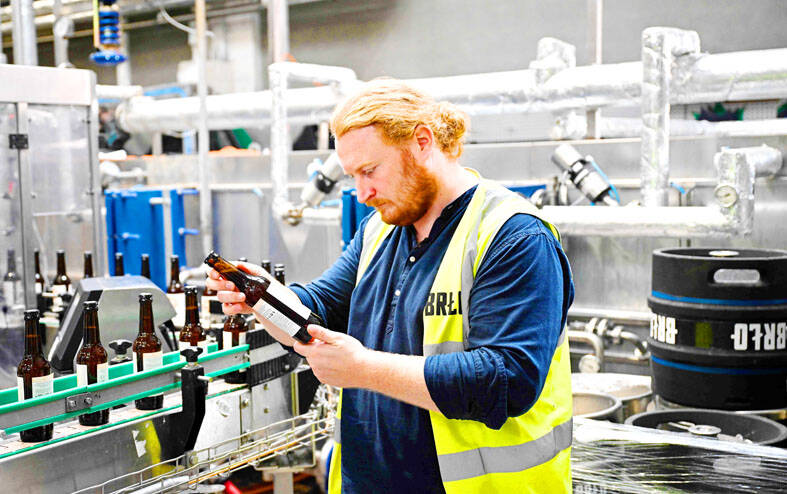All the fun of the Oktoberfest, without the hangover: Germans are swapping traditional beer for non-alcoholic brews, driven by health concerns and the increasing quality of booze-free options. Beers containing less than 0.5 percent alcohol — the legal limit to be classed as non-alcoholic — are no longer an uncommon sight in the country’s famous beer gardens.
“I like the taste of beer, but I don’t find it reasonable to always drink it with alcohol,” Kathrin Achatz, 40, said at the BRLO beer garden in Berlin.
The volume of non-alcoholic beer produced in Germany has almost doubled over the past 10 years, reaching 670 million liters last year, federal statistics office Destatis said.

Photo: AFP
In a survey last yearby the Allensbach Institute, non-alcoholic beer represented about 7 percent of total beer purchases.
“We are seeing a strong increase in demand,” said Holger Eichele, secretary-general of the German Brewers Federation, which represents the interests of the brewing industry.
BRLO, whose beer garden is in Berlin’s central Kreuzberg district, but which produces most of its beer from a brewery further out in Spandau, was an early adopter.
The brewery, which prides itself on producing all its beer in Berlin, launched its “Naked” non-alcoholic range in 2017.
Since then, sales have grown sharply, jumping 60 percent last year from 2021.
“Since day one, this beer has been appreciated by our customers,” said Michael Lembke, one of the brewery’s managers.
Inside the brewery, about 15 workers clad in heavy boots assemble orders in a maze of pipes and conveyor belts.
About 160 hectoliters of Naked beer are produced here every month.
Launched in the 1970s, non-alcoholic beer was initially designed for a niche market: motorists, pregnant women or recovering alcoholics.
But in the past few years, the booze-free beverage has broken into the mainstream. The number of brands on offer has doubled since 2010 to reach more than 700, the German Brewers Federation said.
This is partly down to improved brewing techniques that have led to an increase in quality — something that had previously held non-alcoholic beer back from breaking into the mass market.
At BLRO, the drink is made with a special yeast that prevents alcohol from being created during fermentation, without compromising on flavor. The beer is fermented for a week in the brewery’s huge gray vats.
The boom in non-alcoholic beer in Germany has also been partly down to health trends and a growing awareness of the harmful effects of alcohol.
“There is a growing awareness of health imperatives in the population,” Eichele said.
“Sometimes you want to have a drink, but you don’t want to feel the effects of alcohol,” said Max Thomas, a 44-year-old Briton based in Berlin.
Although Germans are among the biggest consumers of alcohol in the world, at 10 liters of pure alcohol per inhabitant per year, consumption is falling, especially among young people.
A study by the German Federal Centre for Health Education found that 8.7 percent of young people aged 12 to 17 drink alcohol at least once a week. In 2011, that figure was about 14 percent, and in 1979 it was 25 percent.
The average German consumed 87.2 liters of beer last year, compared with nearly 100 liters in 2013, according to Destatis.
The industry is therefore expecting non-alcoholic beers to continue to grow, with the federation predicting they would eventually account for 20 percent of the market.
“It will not completely replace classic beer, but it has enormous potential,” Eichele said.

Intel Corp chief executive officer Lip-Bu Tan (陳立武) is expected to meet with Taiwanese suppliers next month in conjunction with the opening of the Computex Taipei trade show, supply chain sources said on Monday. The visit, the first for Tan to Taiwan since assuming his new post last month, would be aimed at enhancing Intel’s ties with suppliers in Taiwan as he attempts to help turn around the struggling US chipmaker, the sources said. Tan is to hold a banquet to celebrate Intel’s 40-year presence in Taiwan before Computex opens on May 20 and invite dozens of Taiwanese suppliers to exchange views

Application-specific integrated circuit designer Faraday Technology Corp (智原) yesterday said that although revenue this quarter would decline 30 percent from last quarter, it retained its full-year forecast of revenue growth of 100 percent. The company attributed the quarterly drop to a slowdown in customers’ production of chips using Faraday’s advanced packaging technology. The company is still confident about its revenue growth this year, given its strong “design-win” — or the projects it won to help customers design their chips, Faraday president Steve Wang (王國雍) told an online earnings conference. “The design-win this year is better than we expected. We believe we will win

Chizuko Kimura has become the first female sushi chef in the world to win a Michelin star, fulfilling a promise she made to her dying husband to continue his legacy. The 54-year-old Japanese chef regained the Michelin star her late husband, Shunei Kimura, won three years ago for their Sushi Shunei restaurant in Paris. For Shunei Kimura, the star was a dream come true. However, the joy was short-lived. He died from cancer just three months later in June 2022. He was 65. The following year, the restaurant in the heart of Montmartre lost its star rating. Chizuko Kimura insisted that the new star is still down

While China’s leaders use their economic and political might to fight US President Donald Trump’s trade war “to the end,” its army of social media soldiers are embarking on a more humorous campaign online. Trump’s tariff blitz has seen Washington and Beijing impose eye-watering duties on imports from the other, fanning a standoff between the economic superpowers that has sparked global recession fears and sent markets into a tailspin. Trump says his policy is a response to years of being “ripped off” by other countries and aims to bring manufacturing to the US, forcing companies to employ US workers. However, China’s online warriors